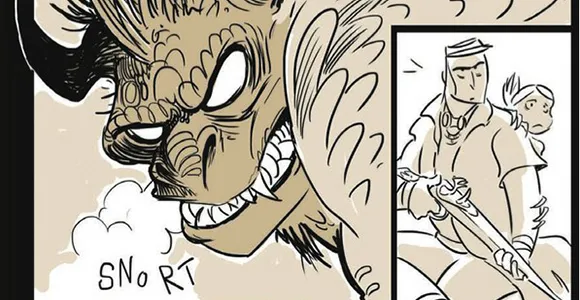“A world without monsters is a dangerous place”
In a world where monsters are very real, City in the Desert opens on a hunter, Irro, and his assistant, Hari, a girl with, as Irro put it, “some of the best attributes of a monkey”—clever, quick, agile, and, uh, a prehensile tail. The father-like Irro appears to be on some sort of solo monster safari—packing unique, homemade weapons, he seems more concerned with taking down the beasts than with studying them. Riding a part-robot part-beast yak-like creature with a monkey-girl at his side, the story seems at first almost like Curious George meets Victorian-era wild game hunters. Had that been the case I would have been perfectly satisfied to read a delightful child-like exploration of this desert world full of strange and mythical beasts and strange, wonderful treasures.
What I got was vastly better and more sophisticated.
With a good sense of world-building awe, City in the Desert develops into an excellent story in a simple visual package. In a world where monsters are the manifestations of the sadness, fear, and pain of its human inhabitants, a single man seeks to “cure” the world of this plague. Yet his cure comes with a terrible price, and it’s up to Irro and and Hari to put a stop to it, to allow people to have their humanity even if it’s in the form of terrible, shadowy monsters that roam the deserts. Here there be monsters, and yet it is not the monsters that are the threat. Shaping up to be an epic adventure, if you like stories with excellent mythic structure, you’ll definitely not regret picking this one up.
We scored an interview with the author/artist of City in the Desert, Moro Rogers, and she kindly took the time to answer some of our questions about this book and her work:
Jaydot Sloane (TMS): What were your influences for this story? I got a very Native American vibe from some of the myths you set up within your books, and I was wondering from where you draw your mythic influence?
Rogers: It’s sort of a mashup of many different myths. I wanted it to have a vague Mesopotamian/Old Testament feel, but I didn’t want to include anything that would place it too firmly in a real culture. The visual style is an homage to the Watership Down movie. I saw it as a little kid and it scared the crap out of me.
TMS: Ahhhh, who wasn’t traumatized by that movie? You know, I grew up in southern Arizona in the desert, and I can imagine I projected my own experiences onto your comic just from the palette and the setting. It’s kind of cool that the style is fluid enough to adapt to the reader!
Rogers: I grew up in Delaware, which is pretty humid and flat, so deserts still seem kind of exotic. (So does SoCal, even after living there for ten years.) My family took a lot of trips to Arizona and Utah, which made a big impression on me. Much of the scenery in CITD is based on Utah.
TMS: I understand these are your first graphic novels. What were you doing before working on City in the Desert? What provoked you to undertake drawing and writing a graphic novel?
Rogers: I had some odd jobs in animation studios, but I had always wanted to do my own story. When I found myself out of work for a while, I realized it was a good time to make something exactly the way I wanted it.
TMS: Living the dream! Did it turn out exactly the way you wanted it? Were there things you ended up leaving out that you wish you’d been able to realize on the page?
Rogers: I feel like it turned out pretty good, better in some ways than I had hoped. The story took some directions that I didn’t expect at the beginning. As for leaving things out, I wish I had made the scenery and props look better. I never liked drawing buildings, so the city backdrops are very minimal. I feel like maybe I’m getting the hang of buildings, but it’s pretty late in the process.
TMS: I’m obviously a fan of your work already, but what would you tell people for whom this might be a step outside their comfort zone? What gets you most excited about your own work?
Rogers: If you like Miyazaki, Harryhausen, and Forbidden Planet, you might like this. I guess what excites me most about my work is that I can leave out anything I don’t think is important.
TMS: Such as?
Rogers: A lot of heavy rendering on the characters’ faces, dialogue written to conform to Robert McKee‘s ideas about screenwriting, that sort of thing.
TMS: What comes next? More graphic novels? A webcomic? A return to life before this crazy adventure?
Rogers: More graphic novels! I’m working on a new one about dinosaurs.
TMS: Well that’s quite a teaser. Dinosaurs in space? Cowboy dinosaurs? Facts about dinosaur feet? Surely you can tell us more.
Rogers: It’s going to be called Raptor vs. Rex. After CITD I wanted to do something a little simpler.
TMS: Awesome! Well I’m definitely looking forward to not only the rest of City in the Desert, but also your new work. Thanks for talking with us!
City in the Desert is written and drawn by Moro Rogers, and is available from Archaia.
Are you following The Mary Sue on Twitter, Facebook, Tumblr, Pinterest, & Google +?









Published: Apr 9, 2014 11:45 am